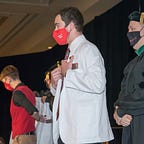Paul Revere’s Ride
The fabled mission may not be everything you thought you knew about it.
The British are coming!
Unfortunately, this phrase was never actually called out by Revere during his ride to Lexington. Historians now hypothesize that Revere may have actually referred to the British as just regulars, a term for their standing military. Additionally, Revere probably just exclaimed that the soldiers were on the move and did not use the word “coming”. So, who was Paul Revere, and how did he end up on this legendary mission?
Paul Revere was born on January 1, 1735. He was the third born of 12 to French Huguenot Apollos Rivoire and Deborah Hitchborn. Apollos arrived in Boston in his adolescence and would later anglicize his name to Revere.
Paul would grow up in Boston and follow in his father’s footsteps as a prominent silversmith. During the mid 1760s, however, Revere’s business would struggle following the Seven Years’ War and the Stamp Act of 1765. This led Revere to take up an unexpected interest in dentistry. This experience would link Revere up with a prominent member of the Sons of Liberty, as the group would later be called, Dr. Joseph Warren. Dr. Warren was a leading outspoken voice against the British along with Samuel Adams and John Hancock in the years leading up to the Revolution. Revere’s dealings with Dr. Warren would be what got the ball rolling for Revere’s ride a number of years later.
The Midnight Ride
Skipping ahead about 10 years, British and American tensions were reaching a boiling point. On the evening of April 18, 1775, Dr. Warren requested that Revere make the trip to nearby Lexington and Concord to warn the citizens that the British regulars were going to be in the countryside. Additionally, Revere was to inform Samuel Adams and John Hancock, who were in Lexington, that the British were coming for their arrest, which may have in fact been untrue and a misnomer on the part of Dr. Warren.
On this evening, there were many conditions to watch out for. The British were either going to travel out of Boston by sea or by land through the Boston Neck, which led out of the city. This would be displayed by a signaling of two lanterns in a church tower if Revere was unable to leave the city.
Ultimately, Revere traveled out of Boston by boat and landed on the Charlestown bank just north of Boston. From here, he met with other Sons of Liberty and saddled up for his ride. He left Charlestown around 11 PM, taking a convoluted path, to avoid attention of British officers in the area, through Medford and Arlington, making it to Lexington around midnight.
Once in Lexington, Revere approached the house where Adams and Hancock were staying. After some back-and-forth with a guard stationed outside, Revere was able to convey his message that Dr. Warren had given him. Once this was relayed, Revere set off to nearby Concord to ensure that powder and supplies being stored there were safe from British destruction.
This part of the mission would prove to be unsuccessful, however, as Revere was captured and did not make it to Concord. His horse was taken by the British there, and Revere would later walk back towards Lexington, to catch the end of the Battle of Lexington unfolding.
Common Misbeliefs About Revere’s Trip
Many of us have heard the story of Revere’s ride. There have been many renditions and ideas thrown around, but historians now believe much of what we thought we knew is false. Here are a few lesser known realities of that evening:
- His words, “The British are coming!” were not actually spoken. As stated before, this most likely was not what Revere actually called out into the night. Yelling this would simply have been too attention-grabbing.
- Revere borrowed his famed horse. The horse could not have been Revere’s own as many have thought. He would not have been able to transport it out of Boston. It is widely accepted that Revere actually used a horse named Brown Beauty from John Larkin, who was a Charlestown Merchant.
- Henry Wadsworth Longfellow’s 1861 poem is not an accurate account. Unfortunately, the poem that many of us have read and taken to heart is not a true description of night’s events.
- Revere did not ride alone. In actuality, Revere was joined by fellow riders William Dawes and Dr. Samuel Preston, if not even more. As many of us assumed and Longfellow writes, Revere was not the sole patriot on that evening.
- Revere did not finish his riding mission. Although he did warn Hancock and Adams of the British movement towards Lexington, Revere never made it to Concord to check on the munitions due to a British checkpoint.
Closing Thoughts
Though much of what we once learned about Paul Revere and his patriotic outing may have turned out to be misinformation, Revere still can be praised for his willingness to take on the task. With little known of what resistance he would face outside of Boston, Revere took the assignment and delivered a significant message to Adams and Hancock, whether the warning was necessary or not.
Regardless of what is true and what is not, Paul Revere’s Ride is still a legendary tale in the book of the American Revolution and an exciting story to share.
Grant Fuerstenau is a Medical Student at the University of Louisville School of Medicine and the editor of The Biographical Historian.
